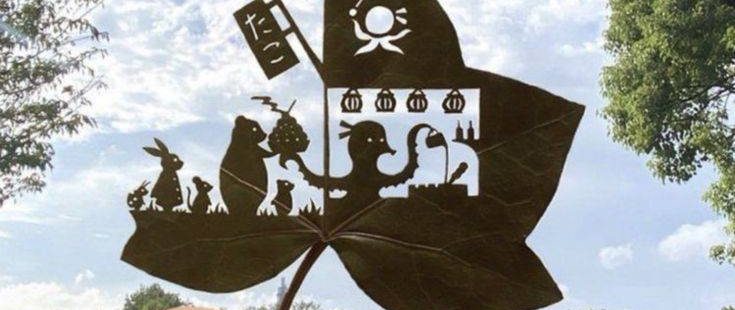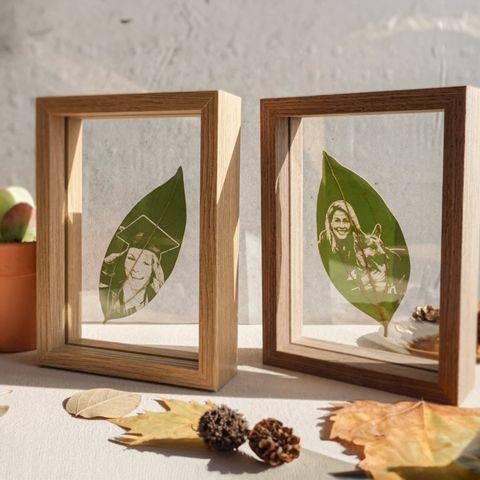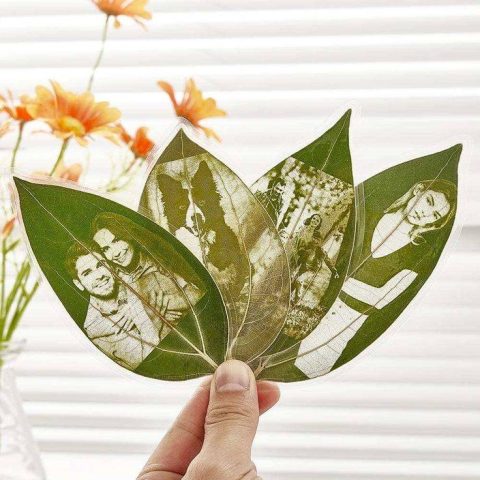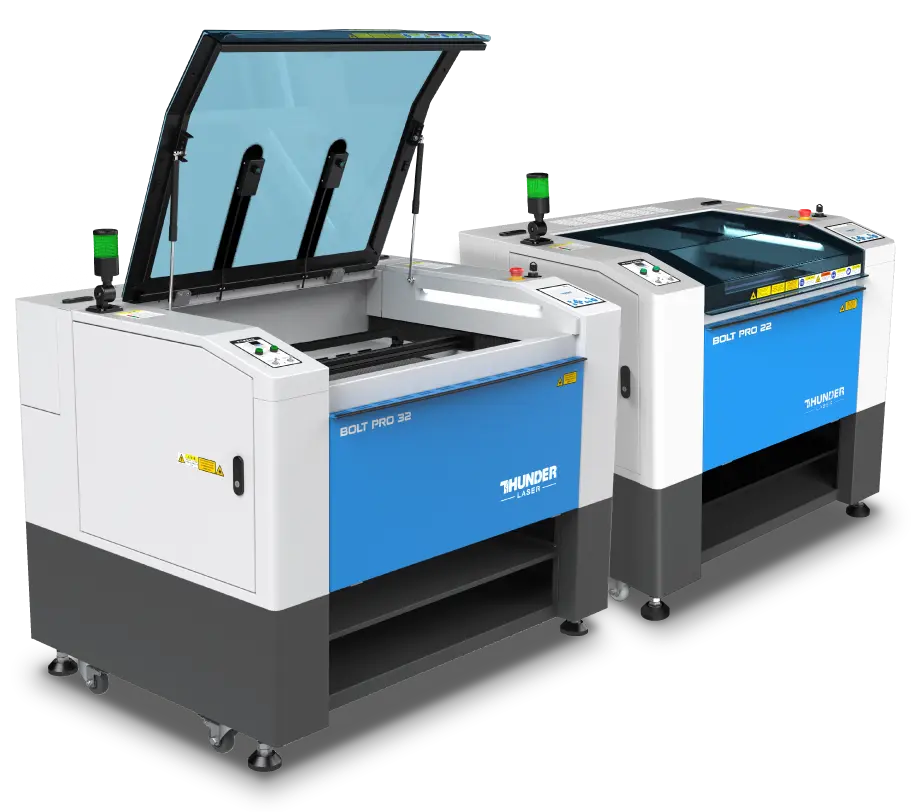- Author: Virgil
Laser engraving leaves is a fascinating fusion of technology and nature, enabling the creation of intricate designs on organic materials. This process provides a unique method for artistic expression, eco-friendly branding, and personalized keepsakes. By leveraging precise laser technology, crafters and businesses can transform delicate leaves into remarkable works of art.

1. What Is Leaf Laser Engraving?
Laser engraving involves using a concentrated beam of light to remove surface material, creating precise patterns and textures. When applied to organic materials such as leaves, the laser subtly burns the surface, leaving behind intricate designs without compromising the leaf’s delicate structure. The level of detail achieved depends on factors such as laser power, speed, and the type of leaf used.
How Laser Engraving Enhances the Natural Beauty of Leaves
Unlike traditional carving or printing methods, laser engraving interacts directly with the organic fibers of a leaf, accentuating its natural veins and contours. This technique enhances the leaf’s inherent beauty while adding intricate details, making each piece one-of-a-kind. The contrast between the engraved and non-engraved portions highlights the uniqueness of every creation.
2. Choosing Leaves for Laser Engraving
2.1. Best Leaf Types for Engraving
Not all leaves are suitable for laser engraving. Thick, sturdy leaves such as magnolia, oak, and rubber plant leaves are ideal due to their resilience. Leaves with a waxy or fibrous texture engrave well, providing a high-contrast effect.
Here we have a comparing table among common types of leaves to laser engrave:
| Leaf Type | Durability | Engraving Contrast | Surface Texture | Best Use Cases |
|---|---|---|---|---|
| Magnolia | High | Excellent | Waxy, thick | Decorative art, branding, long-lasting projects |
| Oak | Medium | Good | Fibrous, sturdy | Rustic art, botanical collections, framed pieces |
| Rubber Plant | High | Excellent | Waxy, flexible | Personalized decor, intricate patterns |
| Maple | Medium | Moderate | Thin, veined | Wedding decor, nature-inspired crafts |
| Banana Leaf | Low | Low | Smooth, delicate | Temporary artwork, eco-friendly projects |
| Fern | Low | Moderate | Fragile, small | Decorative accents, fine-detail engravings |
2.2. Fresh vs. Dried Leaves
Fresh leaves offer flexibility and a vibrant color contrast after engraving but can deteriorate quickly. Dried leaves, on the other hand, are more fragile but provide a rustic, antique appeal and are easier to preserve. Choosing between fresh and dried leaves depends on the intended application and longevity required.
| Feature | Fresh Leaves | Dried Leaves |
|---|---|---|
| Durability | Flexible, less prone to breaking | Fragile, can crumble easily |
| Engraving Contrast | Moderate to high contrast | Higher contrast, antique look |
| Surface Texture | Waxy or fibrous, retains moisture | Brittle, can have natural wrinkles |
| Longevity | Short-term, degrades over time | Long-lasting if preserved properly |
| Best Applications | Temporary decor, branding | Framed artwork, keepsakes, gifts |
2.3. Tips Before Preparing Leaves
Before engraving, leaves should be cleaned to remove dust and debris. Flattening them under a weighted press ensures a smooth engraving surface. Moisture content should also be considered, as overly brittle or damp leaves can affect engraving quality. Follow these tips, the results will be more optimized:
- • Clean the Surface – Gently wipe leaves with a dry or slightly damp cloth to remove dirt, dust, and oils that may interfere with engraving.
- • Flatten the Leaves – Press leaves between heavy books or a weighted press for a few hours to ensure a smooth, stable engraving surface.
- • Check Moisture Levels – Avoid leaves that are too damp (may burn) or too dry (may crumble). A slight moisture balance ensures cleaner engraving.
- • Select the Right Thickness – Medium-thick leaves provide the best results; too thin leaves may burn, and overly thick leaves can be harder to engrave.
- • Test Engraving on a Sample – Before engraving on the final piece, test on a similar leaf to fine-tune laser settings.
3. Innovative Uses for Laser-Engraved Leaves
Laser-engraved leaves offer a unique blend of natural beauty and precision artistry, making them perfect for a variety of creative applications. Whether used for decor, branding, or personal expression, engraved leaves provide an eco-friendly alternative to traditional materials. Below are six inspiring projects that showcase the versatility of laser-engraved leaves.
3.1. Personalized Wedding Place Cards
Engraved leaves make stunning and sustainable place cards for weddings and formal events. By etching guests’ names onto fresh or dried leaves, couples can add a personalized touch to table settings while maintaining an elegant, nature-inspired aesthetic. Choosing leaves that match the wedding’s color scheme—such as gold-engraved magnolia leaves for a rustic theme—enhances the event’s decor. These biodegradable place cards also eliminate waste, making them a popular choice for eco-conscious celebrations.
3.2. Custom Botanical Bookmarks
For book lovers and gift-giving occasions, engraved leaves can be transformed into delicate, nature-inspired bookmarks. Dried leaves with intricate laser-etched quotes, floral patterns, or personalized initials make for an eye-catching alternative to traditional bookmarks. To enhance durability, these bookmarks can be coated with a thin layer of resin or laminated, ensuring they remain intact through extended use. This project is especially popular among artisan crafters and eco-conscious brands looking to sell unique literary accessories.
3.3. Engraved Leaves for Jewelry and Accessories
Tiny, laser-engraved leaves can be turned into one-of-a-kind jewelry pieces such as pendants, earrings, or brooches. With detailed engraving techniques, artists can imprint names, symbols, or fine artistic patterns onto leaves before sealing them with resin for preservation. This method captures the delicate veining and organic structure of the leaf while adding intricate custom designs. These nature-inspired accessories appeal to those who appreciate botanical aesthetics and handcrafted, sustainable jewelry.
3.4. Decorative Wall Art
Engraved leaves can be framed and displayed as elegant botanical artwork. Whether arranged in a shadow box or mounted on canvas, these laser-etched leaves create an eye-catching fusion of nature and craftsmanship. Artists often incorporate poetry, intricate floral motifs, or even miniature landscape designs onto the leaves, resulting in personalized, high-detail artwork. This project is ideal for home decor, gallery exhibits, and unique handmade gifts.
3.5. Eco-Friendly Business Cards
For businesses that emphasize sustainability, laser-engraved leaves can serve as a creative alternative to traditional business cards. By engraving a company logo, contact details, or a brief brand message onto sturdy leaves, businesses can create memorable, biodegradable promotional items. These nature-inspired business cards not only reduce paper waste but also leave a lasting impression on clients who appreciate innovative and sustainable branding approaches.
3.6. Engraved Leaves for Luxury Branding
High-end brands and eco-conscious companies use engraved leaves as part of their product packaging to convey an organic, artisanal image. Luxury chocolate brands, perfumeries, and handmade skincare businesses have adopted this trend by incorporating engraved leaves into their packaging designs. The natural texture and biodegradable quality of leaves align perfectly with environmentally responsible branding, offering a sophisticated yet sustainable way to enhance a product’s presentation.



4. Ideal Laser Settings for Leaves Laser Engraving
Engraving leaves requires careful tuning of laser parameters to avoid burning or excessive damage. Here are the recommended settings for optimal results:
- • Power Output: Low-power settings between 5W and 15W are ideal for engraving without scorching. Higher power settings can be used on thicker leaves like magnolia, but should be tested first.
- • Speed Settings: A high-speed engraving mode (300-500 mm/s) ensures that the laser moves quickly over the surface, preventing prolonged heat exposure that can cause burning.
- • DPI (Dots Per Inch): Using a lower DPI (250-400) reduces laser passes, which helps maintain the natural texture of the leaf while still achieving fine detail.
- • Air Assist: Setting air assist to a low or moderate level prevents excessive charring while keeping engraving clean and sharp.
For optimal results, it is recommended to test settings on a sample leaf before working on the final project. This allows for adjustments based on the leaf’s thickness, moisture content, and texture.
Learn more: Best Laser Settings for Various Materials
5. Best Laser Engraving Machine for Leaf Projects
When engraving delicate organic materials such as leaves, choosing the right laser type is critical for achieving precise and visually appealing results.
CO₂ lasers are the preferred option because their infrared wavelength (typically 10.6 μm) is readily absorbed by organic compounds like cellulose, allowing for controlled engraving without excessive burning. In contrast, fiber lasers operate at a much shorter wavelength (typically 1.06 μm), which is highly effective for engraving metals but too intense for plant-based materials, often leading to scorching and disintegration of delicate leaf structures.
Thunder Laser Bolt – A Compact CO₂ Leaf Laser Engraver
The Thunder Laser Bolt Series is a versatile and compact CO₂ laser machine that is particularly well-suited for engraving delicate materials like leaves. With power options ranging from 30W to 55W, it provides precise control over engraving intensity, allowing users to create high-detail patterns without excessive charring. Its high-speed engraving capabilities and adjustable air assist minimize heat accumulation, preserving the integrity of fragile leaves. Additionally, the compact design makes it an excellent choice for small-scale projects, hobbyists, and artists who want to experiment with organic engraving.
6. How to Laser Engrave a Leaf with Thunder Laser Bolt
Engraving a leaf requires precision, the right settings, and proper preparation to ensure a crisp, detailed design without burning or damaging the delicate surface. Follow this step-by-step guide to achieve optimal results using the Thunder Laser Bolt.
6.1 Materials to Prepare
- • Thunder Laser Bolt
- • A Piece of Mape Leaf
- • Microfiber Cloth
- • Flat Press or Heavy Book
6.2 Step-by-Step Guide to Laser Engrave a Leaf
Step 1: Clean and Flatten the Leaf
Before engraving, gently wipe the leaf with a microfiber cloth to remove dust and debris. Any particles left on the surface may interfere with the engraving process, resulting in an uneven finish.
For optimal results, press the leaf between parchment paper under a heavy book for 24 hours. Flattening the leaf helps create a stable engraving surface and prevents unwanted curling during the process.
Step 2: Position the Leaf on the Engraving Bed
Place the leaf on a non-reflective backing, such as a piece of cardstock or a wooden board, to prevent shifting. Use painter’s tape on the edges if necessary to secure it without causing damage.
The Thunder Laser Bolt’s Red Dot Pointer feature can help align the leaf with the engraving design before starting.
Step 3: Upload the Design and Check the Parameters
Import your design into LightBurn or RDWorks and connect to the Thunder Laser Bolt. Adjust the laser settings based on the fragility of the leaf.
Recommended settings:
- • Speed: 1000mm/s
- • Power: 60%
- • DPI: 200
Running a test on a spare leaf is highly recommended to fine-tune these parameters before final engraving.
Step 4: Locate the Design on the Leaf
Positioning is key to achieving precise engraving. Use the Red Dot Positioning feature to align the design with the natural contours of the leaf.
Enable the Auto Focus function to adjust the laser head’s height, ensuring a uniform engraving depth without scorching the delicate material.
Step 5: Start Laser Engraving
Once aligned, begin the engraving process. The Thunder Laser Bolt’s high-speed CO₂ laser carefully etches the design onto the leaf’s surface with minimal heat impact, preserving its natural structure.
To prevent excessive burning, use multiple light passes instead of a single deep engraving. The built-in exhaust system will help remove any smoke or particles generated during the process.
Step 6: Clean and Preserve the Engraved Leaf
After engraving, gently wipe the leaf with a dry cloth to remove any residual dust.
For long-term preservation, consider applying a light coat of clear spray sealant or laminating the engraved leaf. This protects it from moisture, air exposure, and eventual deterioration.
Follow this guide, you will get a successful laser engraving on leaves, with maintaining the integrity of the natural material.
Conclusion
Laser engraving on leaves merges art, technology, and sustainability into a single creative process. By selecting the right leaves, fine-tuning engraving settings, and preserving finished pieces, artists and businesses can craft intricate, nature-inspired works that stand the test of time. Whether for decorative purposes, branding, or eco-friendly initiatives, engraved leaves offer limitless potential in the world of laser artistry.
FAQs about Laser Engraving Leaves
Q1. What types of leaves are best for laser engraving?
Thick, sturdy leaves with waxy or fibrous surfaces—such as magnolia, rubber plant, and oak—are ideal. These types hold up well under laser exposure and provide better contrast and detail.
Q2. Can both fresh and dried leaves be laser engraved?
Yes. Fresh leaves are more flexible and vibrant but have a shorter lifespan. Dried leaves are more fragile yet easier to preserve, offering an antique aesthetic ideal for keepsakes or framed art.
Q3. What laser settings should I use to engrave a leaf without burning it?
Use low power (5–15W), high speed (300–1000 mm/s), and low DPI (200–400). Always run a test pass on a similar leaf first to fine-tune the settings and avoid scorching or uneven depth.
Q4. How do I prevent leaves from curling or moving during engraving?
Flatten the leaf under a heavy book for several hours and secure it on the laser bed with painter’s tape or a non-reflective backing like cardstock. This ensures stability and consistent results.
Q5. How can I preserve a laser-engraved leaf for long-term display?
Apply a clear spray sealant or encase the leaf in resin or laminate. For an elegant finish, frame the leaf in a shadow box to protect it from moisture, air, and handling damage.



.png) International
International
 United States
United States
 Brasil
Brasil
 Canada
Canada
 Costa Rica
Costa Rica
 Česká
Česká
 Ελλάδα
Ελλάδα
 Polska
Polska
 Ireland
Ireland
 Portugal
Portugal
 Lietuva
Lietuva
 Россия
Россия Deutschland
Deutschland
 Britain
Britain
 Україна
Україна
 France
France
 Sverige
Sverige
 Italia
Italia
 Norway
Norway
 Denmark
Denmark
 Romania
Romania
 한국
한국
 中国
中国
 ประเทศไทย
ประเทศไทย
 中国香港
中国香港
 Israel
Israel
 中國臺灣
中國臺灣
 India
India
 پاکستان
پاکستان
 پශ්රී ලංකා
پශ්රී ලංකා
 ジャパン
ジャパン
 Australia
Australia
 New Zealand
New Zealand
 South Africa
South Africa